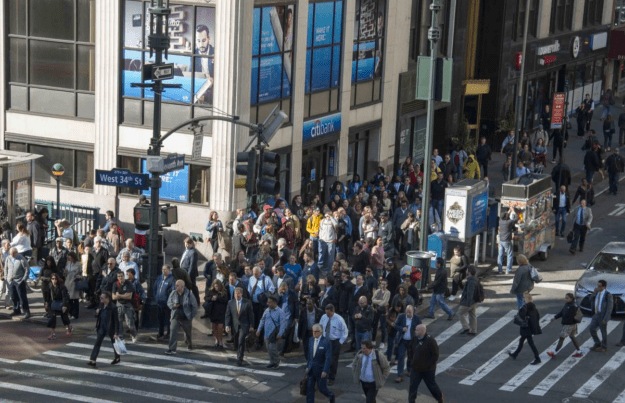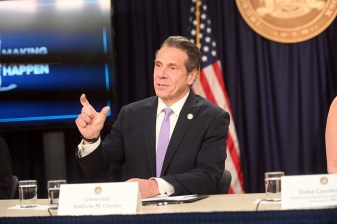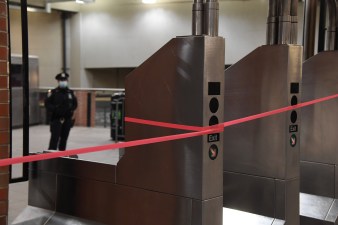Op-Ed: Dear Gov. Cuomo, The Problem Is Crowding, Not ‘Density’!
The coronavirus crisis show why New York's leader must move forcefully to create more space for people, a prominent urbanist argues.


New York Gov. Andrew Cuomo has been effectively using the megaphone of daily press briefings to bring essential attention to New York City’s pressing needs during the coronavirus crisis, and in doing so has become an important leader at a time of great crisis.
There’s just one thing I really wish he would stop doing: We all need him to stop saying over and over that New York’s problem, the reason for the fast spread of the virus in Gotham, is “density.”
Because it’s not.
It may seem like a small thing, but by making density the villain, in the long term, his forceful and persuasive TV performances may inadvertently be damaging the very city he is trying to help — and maybe other cities, too.
New York’s problem isn’t density — it’s crowding.
Many think that’s the same thing. It’s not. Density is generally used as a measure of how many people live and work on how much land, or how much building space is in an area. Crowding is literally how close everyone is to each other at a given time and place. You can have density without crowding, and you can have crowding without density. We’ve seen examples of each during this pandemic.
The problem isn’t density. Density is good for cities in many ways even during a pandemic, including supporting urban hospitals, walkable shopping & services, etc. The problem are crowds. Please change your language —there could be long term consequences for the future of cities.
— Brent Toderian (@BrentToderian) April 2, 2020
And as many have been pointing out recently, many cities that are MUCH more dense than New York have fared MUCH better during this pandemic, and even in New York itself, cases of COVID-19 don’t correlate with the more dense parts of the city. In fact, New York City’s “suburban” borough, Staten Island, actually has the highest rate of infection, with 14 more cases per 100,000 residents than in the densest borough, Manhattan. Global and national analysis is showing linkages among virus spread and governance directives, leadership (or lack thereof), stupidity (Florida beaches, anyone?), and sadly poverty (THAT needs a lot more discussion), but NOT density.
Gov. Cuomo just has to change his language to reflect that difference — stop referencing density as the problem, and start referencing crowding as the problem. You could even start noting that density is actually one of New York’s greatest strengths.
I’ll say this again — altho there’s an immediate need to reduce CROWDS, there is NOT a need OR benefit to reducing URBAN DENSITY after #COVID19. What we’ll NEED is an smart conversation about doing density BETTER, expanding on what I’ve been calling #DensityDoneWELL for 15 years.
— Brent Toderian (@BrentToderian) March 31, 2020
Density is good for cities and their inhabitants in many ways — even during a pandemic, because it supports the existence of many local things like superior urban hospitals, quick emergency responses, walkable shopping and services, and other social amenities that aid health and wellness. When it’s done well, density famously provides the creative catalyst of human interaction that makes cities successful, creative, and great.
And density WILL be a critical key in addressing the climate crisis, which among many other things could easily lead to more frequent and deadly pandemics. We NEED density as part of the solution to our many challenges, although we also badly need a ramped-up conversation on how to do density better, safer and more successfully post-COVID-19, building on what I’ve called “Density Done Well” for the last 15 years or so. That conversation has already started, and I, for one, have gotten even more pushy about it.
As a simple example of how density can be done well or poorly, New York shamefully has narrowed countless sidewalks during the past 70 years in order to create wider roads for cars. That has nothing to do with density and everything to do with a fixation on cars. And it needs to be fixed for density to be more successful.

In large part, crowding is what happens when we dedicate the vast majority of our public urban space to cars, with not nearly enough left over for people. Sadly, COVID-19 has revealed for those who weren’t paying enough attention just how little space we give to people in our cities, and how much we give to cars. Too little space on our sidewalks and streets, in our parks and public places, in our transit stations, subways and buses, and just about everywhere else. Almost every place seems too tight right now, except for the inside of all those bigger (and more dangerous) SUVs, trucks and cars that we’ve been building each year.
The governor actually seems to get that, as illustrated by his important insistence that Mayor de Blasio open key city streets to people by closing them to cars, in order to create space for physical distancing during the pandemic.
Speaking of better language, we really all have to stop calling it “social distancing.” Here in Canada, experts, media and pretty much everyone reverted to “physical distancing” about a week ago, after pressure from me and many others to recognize the need for continued and expanded social connections during the crisis. The change in language wasn’t hard, but it’s been important and effective.
Beyond the language change, Gov. Cuomo should be encouraged to go further in opening public spaces in New York, hopefully working with Mayor de Blasio, to close more streets to car traffic for the benefit of pedestrians and cyclists. Stop worrying so much about police presence and enforcement — other cities that have successfully done this haven’t had to, and neither does New York.
WATCH & SHARE: Do you think cities need to create MORE space for pedestrians & cyclists while #PhysicalDistancing by closing streets to cars during #COVID19? My FIRST short video response to one of your #QuestionsForToderian questions on cities & city planning. Keep sharing Q’s! pic.twitter.com/CbnrwifGr8
— Brent Toderian (@BrentToderian) March 31, 2020
Have MORE, not fewer places for people to get physical exercise and mental relief. Make them hyper-local, close to where the people are. Make them ordinary and non-sexy (so they don’t become a destination or “scene”). Coordinate them fully with parks, which are the natural partners in this effort. And another small but important detail — get rid of pedestrian “beg buttons.” Be fast, cheap, tactical and creative.
The governor might even order that it happen, as he did with his important decision to finally shutter New York City’s playgrounds, after too much dangerous time went by with them remaining open.
Moreover, as a long-term matter of public health and infection control, and for MANY other public-interest reasons, the governor and Mayor de Blasio must consider making many of these new “open streets” permanent afterward. New York knows how to do it; the city became a global model for exactly this under Mayor Bloomberg and Janette Sadik-Khan. That will require Mayor de Blasio to have a fundamental shift in thinking around the primacy of the car, but I’ve seen (and helped) that happen before, so I know what’s possible if you want it bad enough.
Many of the greatest and most important urban transformations in history have had a crisis as their catalyst. Our global cities have been badly in need of transformation for decades now, to address the many crises that we haven’t been taking as seriously as we are this one.
We really can’t afford for this crisis not to fundamentally change things for the better. We can’t just react to it, or there’s a good chance things WILL get worse as a result (less public transit, more car use, more low-density suburban sprawl, more emissions, accelerated climate change, worse public health, exploding infrastructure costs, and likely more pandemics). Political leaders and urban designers across the globe have already been springing into action. We must choose and PLAN the better post-COVID-19 city, or we really won’t like what we’re going to get. As part of all that, we need more and BETTER density, not less of it.
In the meantime, Gov. Cuomo, PLEASE change your language right away about what the real villain is. Say it with me, everyone: “Crowding.”
City planner and urbanist Brent Toderian (@BrentToderian) is the founder of “advanced urbanism” consultancy TODERIAN UrbanWORKS, and is the former chief planner for Vancouver.




